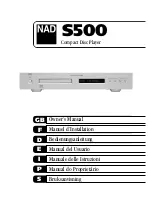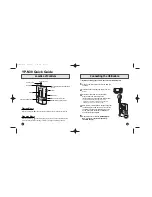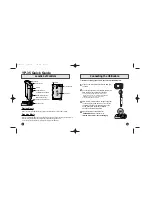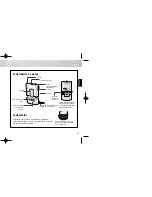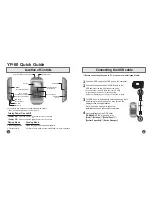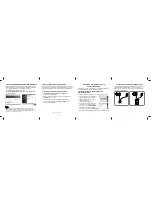
20 -
English
C
onnections
To change HDMI output resolution, see page
32.
HDMI (High Definition Multimedia Interface)
HDMI is an interface to enable the digital
transmission of video and audio data with just
a single connector. Since HDMI is based on
DVI, it is completely compatible with DVI. The
only difference between HDMI and DVI is that
HDMI supports multi-channel audio.
Using HDMI, the DVD Recorder & VCR
transmits a digital video and audio signal and
displays a vivid picture on a TV having an
HDMI input jack.
HDMI connection description
HDMI connector - Both uncompressed video
data and digital audio data (LPCM or Bit
Stream data).
- Though the DVD Recorder & VCR uses a
HDMI cable, the DVD Recorder & VCR
outputs only a pure digital signal to the TV.
- If TV does not support HDCP (High-band-
width Digital Content Protection), snow noise
appears on the screen.
Why does Samsung use HDMI?
Analog TVs require an analog video/audio
signal. However, when playing a DVD, the
data transmitted to a TV is digital. Therefore
either a digital-to-analog converter (in the DVD
Recorder & VCR) or an analog-to-digital
converter (in the TV) is required. During this
conversion, the picture quality is degraded due
to noise and signal loss. HDMI technology is
superior because it requires no D/A conversion
and is a pure digital signal from the DVD
Recorder & VCR to your TV.
What is the HDCP?
HDCP (High-bandwidth Digital Content
Protection) is a system for protecting DVD
content outputted via HDMI from being copied.
It provides a secure digital link between a
video source (PC, DVD, etc) and a display
device (TV, projector
,
etc). Content is
encrypted at the source device to prevent
unauthorized copies from being made.
Note
AV Receiver
Connections
To take full advantage of the movie theatre experience
that DVD offers, you may want to connect your DVD
Recorder & VCR to a complete Surround Sound
system, including an A/V Receiver and six Surround
Sound speakers.
If your A/V receiver is equipped with a Dolby Digital
Decoder, you have the option to bypass the DVD
Recorder & VCR’s built-in Dolby Digital Decoder.
Use the Digital Audio Out connection below.
To enjoy Dolby digital or DTS sound, you must set up
the audio settings. (See page 31)
1
Connect a Digital Audio optical/coaxial cables from
the Digital Audio Out jacks on the rear panel of the
DVD Recorder & VCR to their corresponding
Digital Audio Input jacks on your A/V Receiver:
To Digital Audio Input of an A/V
Receiver with a Dolby, MPEG2 or DTS
Digital Decoder
Manufactured under licence from Dolby Laboratories.
“Dolby” and the double-D symbol are trademarks of
Dolby Laboratories.
“DTS” and “DTS Digital Out” are trademarks of DTS, Inc.
01010Q-VR330/336-XSA-ENG1 2006.3.22 12:18 PM Page 20































